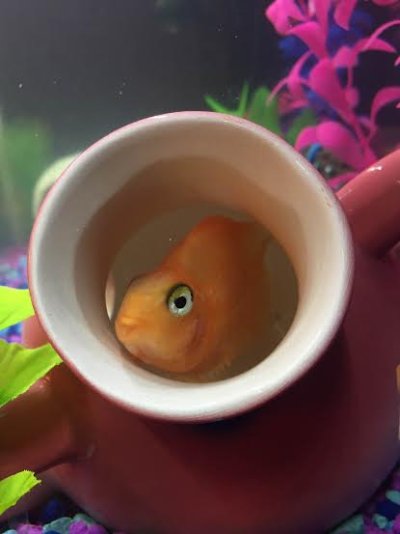katepost28
Aquarium Advice Apprentice
This is my first thread so please bare with me.
1~What type of fish is afflicted?
My blood parrot cichlid has been acting lethargic for about a week. He has not eaten in two days. He ignores his food. His gills are blood red. He also hides at the top by the filter more so than usual.
2~What are your tank parameters (ammonia, nitrites, nitrates, temp, pH)? Ammonia, nitrites, and nitrates are all at 0. This worries me that the API master test kit I have is not functioning. pH is 7.8.
3~ How large is the tank? How long has the tank been set up?
The tank is 20 gall. I have had it set up for 2 months. I did not add the fish until after the first month when I was sure the filter was working and the nitrogen cycle had started.
4~What type of filtration are you using? Please give the name and number (i.e. Fluval 304) and amount of gph if known.
I have a Fluval U2 underwater filter. It's GPH is 105 gallon. I've been using it for two weeks. Prior to that I had a Fluval Aquaclear but it rattled ridiculously and I exchanged it for the U2.
5~How many fish are in the tank? What kinds of fish are they and what are their current sizes?
I have one blood parrot cichlid. He's the only fish and will be the only one. He's a little less than 2in in length.
6~When is the last time you did a water change and vacuum the gravel? How often do you do this? How much water do you remove at a time?
I do water changes weekly. I did the last one Thursday. I did a 25% change.
7~How long have you had the fish? If the fish is new, how did you acclimate it/them? I have had the fish for a month.
8~Have you added anything new to the tank--decor, new dechlorinator, new substrate, etc.? No.
9~What kind of food have you been feeding your fish, have you changed their diet recently? I haven't changed his diet. I feed him Hikari cichlid gold.
I'm very concerned for my little guy. I recently lost the blood parrot I had for 10 years. He was very special to me. I'm now worried I'm going to lose this one. He acted a bit erratic and flighty when I first got him but the blood red gills is what worries me. I am using the API kit but no ammonia or anything has shown up. I don't see any parasites on him. I want to help him but I cannot figure out what's wrong with him.
1~What type of fish is afflicted?
My blood parrot cichlid has been acting lethargic for about a week. He has not eaten in two days. He ignores his food. His gills are blood red. He also hides at the top by the filter more so than usual.
2~What are your tank parameters (ammonia, nitrites, nitrates, temp, pH)? Ammonia, nitrites, and nitrates are all at 0. This worries me that the API master test kit I have is not functioning. pH is 7.8.
3~ How large is the tank? How long has the tank been set up?
The tank is 20 gall. I have had it set up for 2 months. I did not add the fish until after the first month when I was sure the filter was working and the nitrogen cycle had started.
4~What type of filtration are you using? Please give the name and number (i.e. Fluval 304) and amount of gph if known.
I have a Fluval U2 underwater filter. It's GPH is 105 gallon. I've been using it for two weeks. Prior to that I had a Fluval Aquaclear but it rattled ridiculously and I exchanged it for the U2.
5~How many fish are in the tank? What kinds of fish are they and what are their current sizes?
I have one blood parrot cichlid. He's the only fish and will be the only one. He's a little less than 2in in length.
6~When is the last time you did a water change and vacuum the gravel? How often do you do this? How much water do you remove at a time?
I do water changes weekly. I did the last one Thursday. I did a 25% change.
7~How long have you had the fish? If the fish is new, how did you acclimate it/them? I have had the fish for a month.
8~Have you added anything new to the tank--decor, new dechlorinator, new substrate, etc.? No.
9~What kind of food have you been feeding your fish, have you changed their diet recently? I haven't changed his diet. I feed him Hikari cichlid gold.
I'm very concerned for my little guy. I recently lost the blood parrot I had for 10 years. He was very special to me. I'm now worried I'm going to lose this one. He acted a bit erratic and flighty when I first got him but the blood red gills is what worries me. I am using the API kit but no ammonia or anything has shown up. I don't see any parasites on him. I want to help him but I cannot figure out what's wrong with him.


